|


First Published Dec. 2002 by Yakimono.net
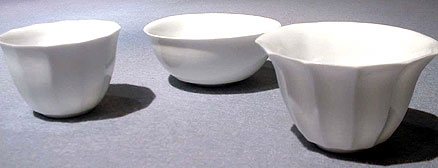
Work by Kimura Yoshiro
I just don't get it. What's up with all this fuss about diets these days in Japan? All those pills and drinks which women, and men, seem to be spending much money on to stay slim. Come on folks, if you ate traditional Japanese food you wouldn't need any diet formulas! I often want to apologize to the Japanese people for the way an American diet has changed the food ways of Japan. Just as there is environmental destruction, so too there is cultural destruction -- in this case the culture of food. After the New Years holiday, with much over-indulgence in eating and drinking, I can forgive folks if they are a bit concerned about being thin -- but, on a daily basis for the rest of the year, the Japanese would be wise to stick to a traditional diet for slimness, and health reasons as well. Being thin?how does this connect to sake vessels (shuki)?
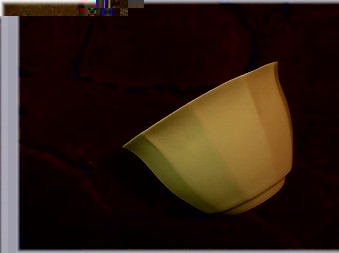
It connects quite a lot actually for hakuji (white porcelain). These days hakuji is quite popular with even a recent Taiyo magazine devoting a whole special issue to the subject. And many contemporary Japanese potters try to make their hakuji as thin as possible, as if the work will waft away into thin air. Now that's not true for all hakuji potters for sure, yet for most it is the case. In a sense they are challenging the clay to become as refined as possible. It doesn't always turn out good though, especially for guinomi (sake cups). One hakuji potter's guinomi I do not want to use at all -- I'm afraid I'll cut my lip! The lip is razor sharp and has no right being that way on a piece that will touch a person's lip. Is this potter trying to assault his clients?
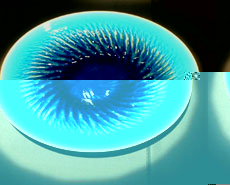 Yet for Hiroshima's Kimura Yoshiro thinness is pureness. Most followers of Kimura are familiar with his splendid aquamarine glaze, called hekiyu. Light sky-blues blend into sapphire tones on all these glazed works. On some the effect of waves is created by a rippling decorative technique, called renmon. They are stunning as seen at his two Tokyo exhibitions last year (2002). Yet for Hiroshima's Kimura Yoshiro thinness is pureness. Most followers of Kimura are familiar with his splendid aquamarine glaze, called hekiyu. Light sky-blues blend into sapphire tones on all these glazed works. On some the effect of waves is created by a rippling decorative technique, called renmon. They are stunning as seen at his two Tokyo exhibitions last year (2002).
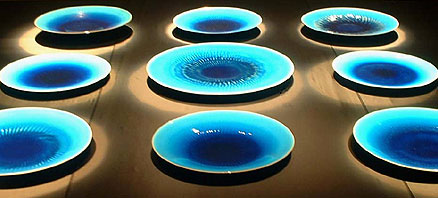
Splendid aquamarine glaze, called hekiyu, and rippling renmon effect
Pieces by Kimura Yoshiro
I was quite surprised to come across his hakuji guinomi at his Mitsukoshi Exhibition and even more pleased to have gotten one -- it is exquisite.
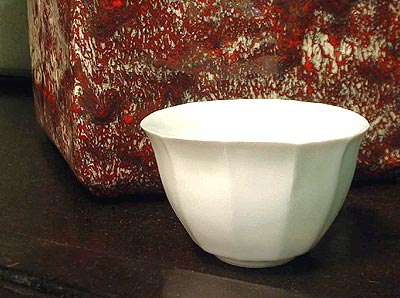
The lip is sharp but angled just right and with a subtle roundness that doesn't threaten my lip with drawing blood. It's so thin that light shines through and I almost feel like my upper and lower lip will touch. The form is small and very light but the feel is large with its twelve-sided body that fits comfortably in my hand. Of course it has a Chinese "feel" to it but it is a work that only Kimura could have made.
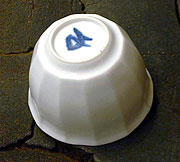 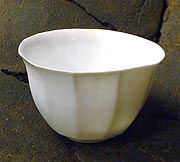
I ran into Kimura in 1999 at a Chinese Song Period ceramic exhibition in Tokyo. Actually we only passed. I was going down an escalator and he was going up. I don't know exactly what pieces stole his heart at that exhibition -- there were so many masterpieces. Yet, I imagine the inspiration for this hakuji guinomi that stole my heart came from that day as Kimura visually ate up all those ceramic art masterpieces.
He "ate a lot" no doubt but still was able to stay slim. If those ceramic works had been food, they might have been hijiki, himono, seasonal vegetables, genmai, and other healthy foods. See, it's not that hard after all to stay slim either in body or on the hakuji works of Kimura Yoshiro. Bon appetit.
Learn more about Japanese porcelain in our Guidebook
|